Guest Post by Eric Peters

Everyone knows about the ongoing classic car show in Cuba. Cars from the ‘50s and ‘60s being used as everyday drivers – by almost everyone.
It’s not because the Cubans appreciate classic cars. It’s because old cars are what they can afford. They keep them running with hand tools and whatever’s handy. Improvise, make it work.
Coming soon, to a town near you – and for similar reasons.
It is my sincere desire to provide readers of this site with the best unbiased information available, and a forum where it can be discussed openly, as our Founders intended. But it is not easy nor inexpensive to do so, especially when those who wish to prevent us from making the truth known, attack us without mercy on all fronts on a daily basis. So each time you visit the site, I would ask that you consider the value that you receive and have received from The Burning Platform and the community of which you are a vital part. I can't do it all alone, and I need your help and support to keep it alive. Please consider contributing an amount commensurate to the value that you receive from this site and community, or even by becoming a sustaining supporter through periodic contributions. [Burning Platform LLC - PO Box 1520 Kulpsville, PA 19443] or Paypal
-----------------------------------------------------
To donate via Stripe, click here.
-----------------------------------------------------
Use promo code ILMF2, and save up to 66% on all MyPillow purchases. (The Burning Platform benefits when you use this promo code.)
A small but growing portion of the driving public is opting out of the new – and “modern” – car market, because new cars have reached an event horizon of cost-too-much/too-much-hassle/too-much-nannying.
Most people have to finance them – for twice or longer the duration of what used to be the traditional car loan (about three or four years) and that ongoing, seemingly interminable expense is compounded by having to pay someone else to fix them – even minor things – because most people can’t fix new/late-model cars themselves. They are too complicated, require specialized tools – including diagnostic equipment – they can’t afford or justify buying.
Cost to fix is going to be an obvious problem in the next few years, as the latest crop of cars with direct-injected, turbocharged engines and transmissions with eight, nine and ten speeds begin rack up miles and things begin to need fixing.
By going older, you can avoid all of this. Cars made before the early 1980s are machines rather than iPhones on wheels. They are mechanical things, not electronic things. The engine is an engine. There it is, simple. If you understand the basics – fuel, air, spark – you can understand its workings and do the fixings. No codes to “pull.” No IV diagnostic hook-up to a $10,000 manufacturer proprietary mainframe that only the dealer has.
No ABS, just brakes. So no expensive ABS pump.
A $20 sealed beam headlight vs. a $300 plastic headlight “assembly.” Sure, the “assembly” produces superior luminosity. And a suite at Trump Towers is nicer than a room at the Holiday Inn.
But when cost is an object… .
Steel wheels that can take potholes without bending and which can be replaced if you ever need to for $10 or so at a parts yard.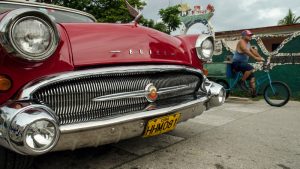
A $35 mechanical fuel pump hanging off the side of the engine that you can get to – vs. a $150 electric pump inside the gas tank.
And – magnificently – no air bags. No chance that your face will be shredded by shrapnel and no worries about the car being a total loss after a deer strike or minor fender bender – otherwise easily and not-too-expensively fixable – on account of thousands of dollars’ worth of “deployed” air bags to replace.
Many of the key components in older cars are not specific to that particular car. The manufacturers – the car companies – used to use the same engines/transmissions (and many other parts) in numerous models, often over long spans of time. Obvious examples of this include the GM “small block” V8 that was basically the same from 1955 through the early ’90s and the Rochester four barrel carburetor and the HEI distributor – all of which were used in millions of different GM models. They easily interchanged, even in cars that were of various vintages. In a modern car, most of the major parts are designed for that specific car – and for the specific combination of options it has. You have to use the same parts – or the computer will have a conniption fit.
And unlike electronic things – which you throw away once they stop working and replace with new parts – mechanical things can often be rebuilt to as-new for next-to-nothing. Example: Cast iron engines which can be bored and honed multiple times, cheaply – vs. aluminum engines that have to be sleeved, expensively. And usually, can’t be re-sleeved much because there’s not enough material in the block to allow for hogging out the cylinder bores.
Most of the old car is fixable by you. And it can be crutched, Band-Aided, gimped, cajoled. Fixed by the side of the road. Modern electronically controlled cars either work . . . or not. They sometimes just stop working. Rarely are they by-the-roadside fixable.
Lower cost to insure – insurance being a function of replacement cost.
Really inexpensive to buy, too.
Mind, we are not talking about the collectibles here. Muscle cars, sexy coupes, the well-known cars – the desirable cars (as far as being collectible). We’re talking transportation. The sedans and wagons.
The homely ones.
Most especially, the economy models. Cars like the Ford Maverick and Chevy Nova and Dodge Dart.
The Pacer and Gremlin. They could be had with V8s, you know.
And yes, even Chevettes and Vegas and Pintos, too. These latter were rear-wheel-drive, a simpler and more durable layout that today is exclusively the layout of expensive performance and luxury-sport cars. There was room to work under the hood of a Chevette or Pinto because its engine was mounted front-to-back and not snugged up against the firewall, making access to one side of it difficult if not impossible with the engine still in the car.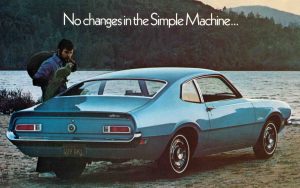
Pulling the transmission – bolted behind the engine – was (and still is) incredibly simple, a matter of removing the 6-8 bolts that secure the transmission case to the rear of the engine and lowering the thing using a floor jack and a piece of 2×4. The rear axle (made of rugged cast iron) in these old-school econo-cars rarely requires anything in the way of maintenance – beyond occasionally changing the gear oil and maybe, at some point, a bearing or race. Compare with the cost of a modern car’s FWD transaxle, CV joints and independent rear suspension.
And before you laugh, realize: Any of those cars can be easily updated with a few key parts that can make them just as reliable and everyday drivable as anything new, but without the seven years of debt servitude, the nanny-state technology (including the lethal air bag technology) and fixable by almost anyone who can turn a screwdriver. 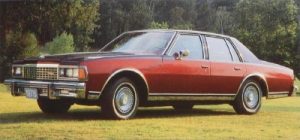
The appeal is, well, obvious.
Which is why now would be a good time time to get in on the action before the inherently limited supply of good candidates disappears. There will also likely be business opportunities for people who can fix these older cars up – maybe updating them in a few key areas, such as adding a simple, stand-alone throttle body fuel injection system in place of a finicky carburetor – and then selling them to people who’d much rather spend say $8,000 on a really nice/mechanically refurbished full-sized ’78 Chevy Caprice with a V8 engine and room for seats six than $18,000 for a new FWD compact with a turbocharged four.
Viva Fidel!


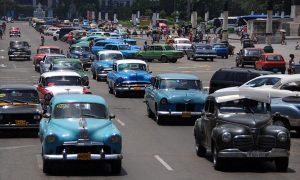
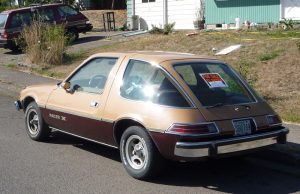


And if you’re a prepper concerned about EMP or CME…
🙂
There are several cars I’m looking for. Once I find them I’ll replace/rebuild the tranny, engine, brakes and steering/suspension parts immediately. That will give a car that is immediately driveable, dependable and easy to repair. A handful of common spare parts are cheap enough to keep on hand at all times.
Any recommendations on selecting a good old diesel powered car?
The Rabbit diesel was pretty sturdy.
I still drive my 79 diesel.
I had an Audi 4000 diesel in the early ’80s. It actually used a VW engine. With the manual transmission it easily got up to 50 mpg on the highway.
The article was like listening to my dad talk about the old days, reminiscing about how life was simpler and how to replace the distributor cap and set the points. Not making light of the article, just saying that just like the simpler America, simpler cars may be a thing of the past that we can pine for, but never experience again (except for the practical few who will shop for a good prepper car/truck, Good on ya!).
I remember a blue 70’s F150 truck I replaced the hydraulic clutch in, under the hood there 25% engine and 75% open area, a pleasure to work in. Hey, I’m talking like my dad!
Cue: “Cats in the Cradle” by Harry Chapin.
I just put new brake pads on my truck, an hour job and I included changing the brake fluid as well since my tester showed too much moisture content.
Oh, I long for the old days when things were so much simpler, four wheel drum brakes with a single master cylinder and manual brake adjustments several times a year so you didn’t have to “pump” the brakes to get them to work.
Those were the days, weren’t they?
Are you serious? You miss four wheel drum cant make the car stop straight brakes? While I dig an older car, as a mechanic, firstly, it needs to be ’74 or older. Different metal, and before the first emissions devices. Late 70’s gms had the rear frames rot right off. Those cuban cars are from the 50’s. Different metal. Doesnt even rot in the salty air.
Gimme hei over points. Btw, not super interchangeable due to mechanical and vaacuum advance requirements. Sleeved aluminum blocks get new sleeves, pistons and rings. Not bored. Still a near impossible task. And there were plenty shitty stupid piss poor designs going back… 4 6 8 caddy motors come to mind. The rest are just heavy and get poor mileage. But if you find an older pre 1974 ford or chevy p/u thats not rusting to death, i’m a player. Problem is thats what everyone is looking for and now they cost more than when they were new. And new they aint.
’65 to 96 Ford’s with the 300 straight six or the old Dodges’s with the 225 slant six – both are bulletproof. Indirect injection 6.2 or 6.5 Chevy Diesels or the pre ’94 Ford 7.3 diesels or the toughest one the ’89 to ’92 Cummins 5.9 diesels.
70′ Monte Carlo with a new sweetass fuel injected crate motor. That’s my next car.
I ruined one of those
Makes me yearn for my Pinto hatchback. Tough little car and it got 30+ mpg consistently.
This why I will never get rid of my 1998 Toyota Tacoma with 471,000 + miles on it. Bought it brand new .It’s easy to work on and not very expensive.Just basic maintenance and it keeps on going.Still gets about 25 miles to a gallon on highway.Best car / truck I have ever owned.
I liked my MG and especially the Triumph which was made to be easily repaired during racing. The Triumph (and Jag) had bonnets with hinges at the front that lifted up (including the fenders) for full access to the engine, screw in cylinders, replaceable inserts for every bearing, downdraft carburetors easily tuned with a pocketknife, knock off wheels, hard and rag tops, and 39 MPG. The shifter was as short and smooth as a 303 Enfield rifle. I’d buy them again and expect someday they will return with electronic ignition and fuel injection.
Does anyone here besides me spend more on a 4 wheeler than they are willing to spend on a car? My car is barely adequate, but my wheelers are the absolute fucking shit.
hot rodders are the worlds first recyclers…
And when the fools in the Prius wince daily on my morning commute as they admire my 56 chevy which garners more admiration than their jap-crap, God smiles
“It’s not because the Cubans appreciate classic cars. It’s because old cars are what they can afford.”
Eric, When you say things like this, it hurts your credibility. 🙁
While it’s true that most Cubans live in relative poverty, the REAL REASON they only have ancient cars is because the USA imposed a trade embargo on Cuba when Castro took power.
There were no new American cars to be had at Any Price.
1986 Izuzu pup diesel. 5 speed manual trans.(that means it has 3 pedals)Top speed is only 60 (downhill) Easy to work on. Makes a great farm truck.